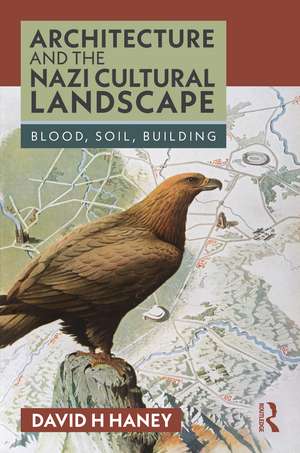Architecture and the Nazi Cultural Landscape: Blood, Soil, Building
Autor David H. Haneyen Limba Engleză Paperback – 13 sep 2022
For the Nazi regime, cultural landscape was indeed a heritage resource, but it was much more than that: cultural landscape was the nation. The project of Nazi racial purification and cultural renewal demanded the physical reshaping and reconceptualization of the existing environment to create the so-called "new Nazi cultural landscape." One of the most important components of this was a set of monumental sites thought to embody blood and soil beliefs through the harmonious synthesis of architecture and landscape. This special group of "landscape-bound" architectural complexes was interconnected by the new autobahn highway system, itself thought to be a monumental work embedded in nature. Behind this intentionally aestheticized view of the nation as cultural landscape lay the all-pervasive system of deception and violence that characterized the emerging totalitarian state.
This is the first historical study to consider the importance of these monumental sites together with the autobahn as evidence of key Nazi cultural and geographic strategies during the pre-war years. This book concludes by examining racial and nationalistic themes underlying cultural landscape concepts today, against this historic background.
| Toate formatele și edițiile | Preț | Express |
|---|---|---|
| Paperback (1) | 291.10 lei 3-5 săpt. | +31.04 lei 4-10 zile |
| Taylor & Francis – 13 sep 2022 | 291.10 lei 3-5 săpt. | +31.04 lei 4-10 zile |
| Hardback (1) | 769.72 lei 6-8 săpt. | |
| Taylor & Francis – 13 sep 2022 | 769.72 lei 6-8 săpt. |
Preț: 291.10 lei
Nou
Puncte Express: 437
Preț estimativ în valută:
55.71€ • 57.55$ • 46.36£
55.71€ • 57.55$ • 46.36£
Carte disponibilă
Livrare economică 04-18 martie
Livrare express 15-21 februarie pentru 41.03 lei
Preluare comenzi: 021 569.72.76
Specificații
ISBN-13: 9781032276939
ISBN-10: 1032276932
Pagini: 358
Ilustrații: 165 Halftones, black and white; 165 Illustrations, black and white
Dimensiuni: 156 x 234 x 17 mm
Greutate: 0.67 kg
Ediția:1
Editura: Taylor & Francis
Colecția Routledge
Locul publicării:Oxford, United Kingdom
ISBN-10: 1032276932
Pagini: 358
Ilustrații: 165 Halftones, black and white; 165 Illustrations, black and white
Dimensiuni: 156 x 234 x 17 mm
Greutate: 0.67 kg
Ediția:1
Editura: Taylor & Francis
Colecția Routledge
Locul publicării:Oxford, United Kingdom
Public țintă
Postgraduate, Professional, and Undergraduate AdvancedRecenzii
"The formal power of buildings in Nazi Germany has tended to focus historical attention upon the architecture at the expense of understanding the larger sites in which they were located. In this fascinating account, Haney forensically examines a range of ‘cultural landscapes’ each conceived to express an aspect of Nazi mythology."
Professor Murray Fraser, The Bartlett School of Architecture, University College London
"This meticulously researched book alerts us to the geopolitical underpinnings of the National Socialist cultural landscape. Never one to bore his audience, David Haney will transform the way in which historians and general readers understand Nazi architectural production."
Associate Professor Ian Klinke, School of Geography and the Environment, University of Oxford
Professor Murray Fraser, The Bartlett School of Architecture, University College London
"This meticulously researched book alerts us to the geopolitical underpinnings of the National Socialist cultural landscape. Never one to bore his audience, David Haney will transform the way in which historians and general readers understand Nazi architectural production."
Associate Professor Ian Klinke, School of Geography and the Environment, University of Oxford
Notă biografică
David H. Haney is an architectural historian whose research focuses on the relationship between architecture, landscape, ecology, and geography. His monograph on the German modernist landscape architect Leberecht Migge (1881–1935), When Modern was Green (Routledge, 2010), was the first study to reassert the critical role of ecological thinking in Weimar modern architecture. He received his PhD in Architecture from the University of Pennsylvania (US) in 2005 and his Master of Environmental Design from Yale University (US) in 1995. From 2005 to 2018 he taught in the architecture schools of the University of Kent and Newcastle University in England. He has lectured widely and has been the recipient of a number of awards including a Leverhulme Trust Research Fellowship (2015–2016) and the SAH Elisabeth Blair MacDougall Award (2013).
Cuprins
Introduction; 1. From Ratzel to Hitler: Biographical Influences, Geopolitics, and Cultural Landscape; 2. Veins of the Nation: The Nazi Autobahn as Geopolitical Propaganda Device; 3. From Sports Park to Sacred Grove: Embedding the Mass Spectacle in the German Landscape; 4. "Secret Societies Established in Broad Daylight": Symbolic Fortifications as Nazi Institutional Sites; 5. Venerating the Blood-Soaked Soil: Monumentalized Landscapes as Memorials; Conclusion
Descriere
This book traces cultural landscape as the manifestation of the state and national community under the Nazi regime, and how the Nazi era produced what could be referred to as a totalitarian cultural landscape. It concludes by examining racial and nationalistic themes underlying cultural landscape concepts today.
